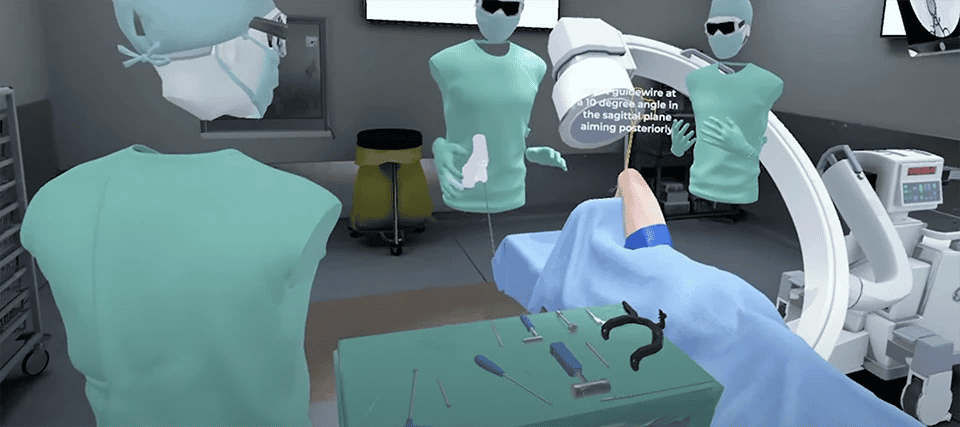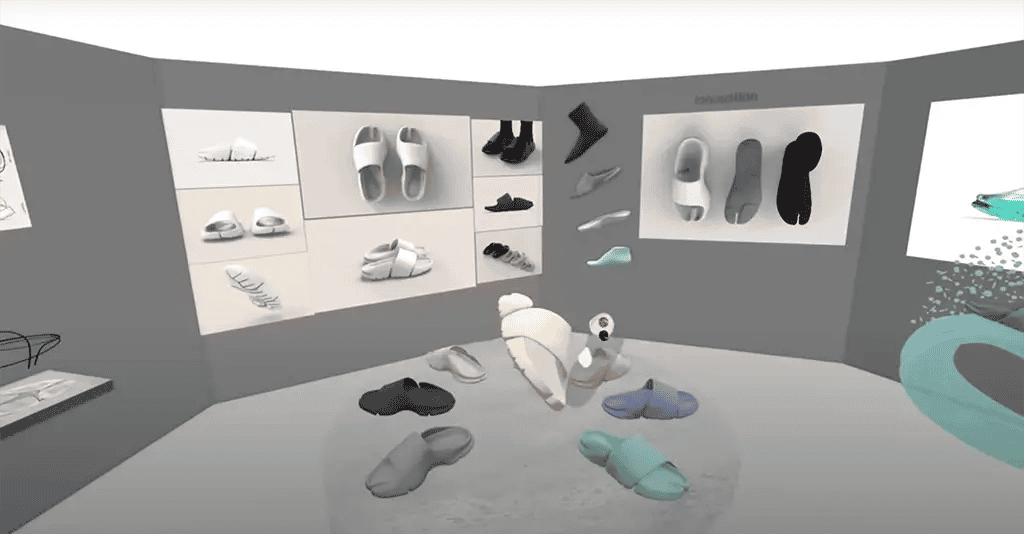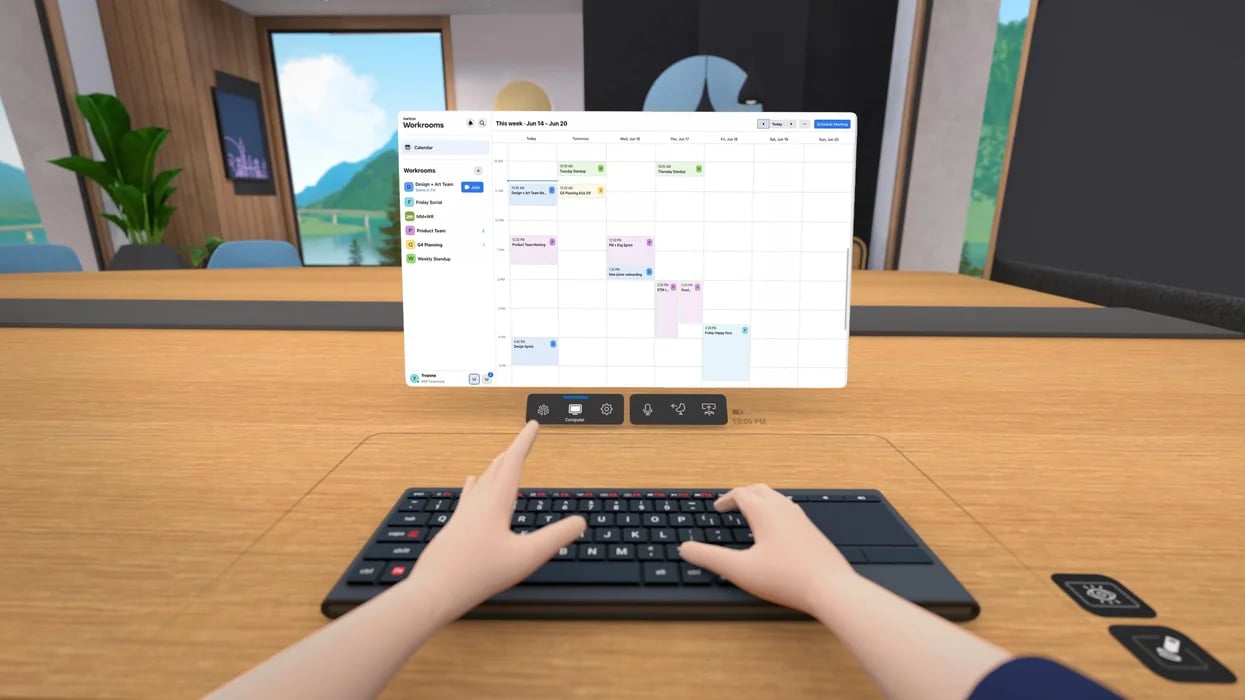As technology advances and businesses rely more on remote work, there is a greater demand for innovative and immersive tools that can bridge the physical gap between employees. This is where virtual reality (VR) comes in. VR has already proven to be a game-changer in the entertainment and gaming industries, but its potential to transform the workplace is just beginning to be explored. There is something for everyone from new ways of learning and training to exploring creativity and design, hosting meetings and events, and improving well-being. In this blog post, we’ll look at the ways in which VR is transforming the traditional 9-to-5 workday and the many benefits it offers to both employees and businesses alike.
Scroll down to a section that interests you by clicking a topic below:
VR: The Revolutionary Tool for Remote Work
VR Training: Learning and Developing Skills with a New Level of Engagement
Design Principles for the Future: Exploring Creativity in VR Environments
How Businesses are Leveraging Virtual Reality for Virtual Meetings and Events
Stress Reduction and Well-Being: VR’s Role in the Workplace
The Future of Working with VR: What Does it Hold?
VR: The revolutionary Tools for Remote Work
Working in a physical space was the only option for a long time. “Work” was a place to go rather than something you did. When technology really started to advance, work became more than just a physical space. It evolved into a physical and digital space - gaining flexibility, speed, autonomy, and efficiency. This combination worked so well because digital tools were never meant to replace the physical office; rather, they were meant to supplement it by making certain tasks or interactions faster and easier.
However, with the outbreak of the pandemic, remote work became a necessity for many businesses. Many people no longer had access (or had limited access) to a physical office space, and those digital tools became the primary way of staying connected. One of the biggest challenges businesses faced was the lack of in-person interactions, which made it difficult to build relationships, exchange ideas, and solve problems.
It's time to redesign the way we work
Simply put, digital technology was never intended to be the primary mode of communication. It’s not enough. Humans are social creatures who require social interactions to maintain healthy relationships, foster emotional connections and create a sense of community. So, how do we find a new balance that embraces a future of hybrid work while still giving us the connection and collaboration we need? What can we do to make our distributed teams feel less isolated and more connected?
The answer may lie in VR. It's an immersive technology that combines the physical and digital worlds in new and exciting ways. As it turns out, VR has a lot to offer when it comes to creating experiences that foster collaboration and connection between remote employees. It has the potential to reconnect us with what we need most from one another while also opening the door to completely new experiences and ways of working. It combines the best of the physical office and digital technologies in a single location - a location that does not have to be fixed but can be wherever we want it to be. And just like that, the virtual space brings a new sweet spot for distributed workers – introducing a sense of presence, spontaneity, stimuli, and freedom.
.png?quality=low&width=860&height=484&name=VR%20for%20Hybrid%20Work-01%20(2).png)
Even though VR has not yet been fully utilized to its full potential, we can safely say that we are living in an era in which VR applications and development will continue to advance. And as we learn more about how to make use of this technology, there is no telling what new applications will be available in the future. But regardless of what comes next, one thing is certain: businesses are sure to benefit from embracing VR as a tool for collaboration and innovation.
Now that we have a better understanding of VR’s potential, it’s time to start thinking about what else it can specifically do for your business. We’ll look at four areas below that each showcases the art of the possible.
VR TRAINING: LEARNING AND DEVELOPING SKILLS WITH A NEW LEVEL OF ENGAGEMENT
We’re all aware that education is important. It’s one of the most important investments a company can make in its people. And yet, traditional learning experiences are often hampered by physical distance or inability to interact with the content in real-time. With VR, this is no longer a problem. Through virtual classrooms and simulations, VR enables remote learning and training experiences that feel just as real as it would in person.
Shifting learning experiences to VR can add an extra layer of dimension. For example, safety training can be implemented in VR to teach employees how to work safely in hazardous environments without ever needing to put them at risk. And personnel development programs, such as soft skills training or product tutorials, can also benefit from the immersive capabilities of VR. This allows learners to practice scenarios or interact with objects in a simulated realistic environment – providing a more engaging, immersive, and impactful learning experience.

Resource: The Johnson & Johnson Institute surgical training and team collaboration with VR
Here are four use cases for how businesses are using VR for training and learning:
Hard skills training: From surgery to retail store training, VR can simulate complex scenarios and environments in a controlled and cost-effective way.
Onboarding: Build custom experiences to immerse new employees in your culture, share knowledge and connect them with mentors.
Soft skills training: Help employees develop key skills like leadership, empathy, or managing difficult conversations through a fully immersive environment.
Safety training: Simulate complex and dangerous scenarios to give people the opportunity to practice in a safe space.
Design Principles for the Future: Exploring Creativity in VR Environments
Every design team understands the value of communicating their ideas and collaborating with their teammates and stakeholders, especially if they are part of a global or distributed company. While 3D design tools have been around for a while, VR is improving the process in a couple of critical ways.
First, by making it easier for design teams to collaborate in real-time and to work on 3D models in shared virtual spaces allows teams to generate ideas faster and easier at scale.
Second, VR makes it easier to communicate ideas to non-design teams. Taking a design from concept to finished product commonly requires the involvement of non-technical teams ranging from marketing to sales, legal, finance, etc. Getting feedback from these teams on 3D designs used to involve 2D renderings or physical mockups. Notes would be in the form of sketches on printed views of digital models, or text-based feedback that design teams would have to take away and interpret. As VR tools make it easier for anyone to put on a headset, join a virtual design lab, and interact with the 3D model directly, this part of the process becomes truly collaborative.

Resource: Gravity Sketch on Meta Quest
What's the end result? A product can move from idea to shelf (or showroom) much faster - increasing ROI. How does this look in real life? Here are four examples to illustrate this use:
3D Design: VR transforms traditional design processes, replacing sketches, computer aided design (CAD) and clay with 3D models that are perfect for real-time collaboration.
Reviews: Change the conversation with clients or stakeholders by literally walking them through creative concepts and identifying areas for feedback faster.
Prototyping: Stress-test new products without investing in physical equipment or ramping up production capacity to increase the pace of innovation.
Data Visualization: Tired of staring at a spreadsheet? Bring data to life with room-scale 3D visualizations and find the answers you’re looking for faster.
Related blogs:
✋ 5 Great Ways to Empower Your Employees In Hybrid Workspaces
Embracing the Digital Age: A Look at the Future of Employee Experience
How Businesses are Leveraging VR for Meetings and Events
Sharing information is essential for building a high-performing hybrid or distributed workforce, whether it is with the entire company at a large event or with a project team in a smaller setting. Because remote work has become the norm, virtual meetings and events are here to stay. What exactly is the challenge? How can these meetings and events be made more engaging and interactive while still maintaining quality and productivity?
Related blog:
What Are The Meetings in The Metaverse? | The Future of Virtual Office
VR is an innovative solution. As we've talked about already, VR allows people to feel as if they are truly present together in the same space, making it a perfect way to build a sense of community, which can become the foundation for everything your company does. Here are four ways businesses are leveraging VR for meetings and events:
Team meetings and workshops: Virtual productivity tools from giant whiteboards to virtual sticky notes to breakout spaces to complex 3D charts help teams get into the nitty gritty together.
Team bonding: Meetings don’t need to end with the presentation. With VR, you can build anything from virtual drinks areas to DJ booths or cafeterias to help bring your community together.
Client meetings: if you’re looking to distinguish yourself as an innovative, future-facing partner to your clients, there’s no better way than inviting them to a meeting, pitch or demo in the Metaverse.
Conferences: bring people together from all over the world without anyone getting on a plane, and take advantage of unique opportunities to share new ideas and to network.

Stress Reduction and Well-Being: VR’s Role in the Workplace
For business leaders, health and well-being have risen to the top of their priority list with good reason. Employees face issues such as digital burnout and isolation. In fact, burnout is on the rise globally while, according to Deloitte, 38% of workers say that lockdown had a negative impact on their mental health. This is not surprising given that employees are spending longer periods of time in front of screens, which can cause physical and mental exhaustion.
The good news is, VR has become a popular tool for stress relief and well-being thanks to its ability to effectively simulate environments that can be calming and relaxing. This technology has been used by companies to create virtual experiences for their employees, to help them relax after a stressful day or take a mental break. Plus, these experiences can even be tailored to each employee's specific needs, such as soothing music, guided breathing exercises, and visualizations of calming scenes.

Gameplay of Tripp for Oculus Quest - Mindfulness Meditation in Virtual Reality.
The Future of Working with VR: What Does it Hold?
In conclusion, the future of working with VR is full of exciting possibilities. The potential applications in the workplace are nearly limitless as VR technology evolves and becomes more accessible. From remote collaboration to immersive training, VR can change the way we work and learn.
As we continue to move towards a more digitized world, it's clear that VR will play a significant role in shaping the way we work and interact with one another. Given the current rate of innovation and investment in VR, it is likely that we will see significant advancements in the coming years. Just look at how much the Metaverse has grown since its launch – and the potential for growth is only getting bigger. With the right strategy and approach, the Metaverse and VR can help businesses create more powerful experiences and foster meaningful connections with their teams, customers, partners, and clients.
As such, it's important for individuals and organizations to embrace this technology and invest in the necessary resources to fully realize its potential. Have you thought about joining the Corporate Metaverse?The future of working with the Metaverse and VR is bright, and it looks promising to bring about a new era of productivity, creativity, and innovation. Start your journey with the right communication tool like Workplace from Meta. At LineZero we've helped many of organizations join the Corporate Metaverse. Ready to be next? Contact us at engage@linezero.com to learn more about how you can start your journey into the future of work.
NOT USING WORKPLACE YET?
Want to see how Workplace could take your internal communications strategy to the next digital level and help you to reach everyone across your organization in a more efficient and effective manner? Give us a shout! Through a live demo of the Workplace platform, we’ll help you to brainstorm ideas on how to utilize Workplace to achieve your organization’s goals and objectives around internal communications.
ALREADY USING WORKPLACE?
If you’d like to explore more opportunities to learn how to use Workplace to improve your internal communications strategy and be part of the corporate Metaverse, we’d love to chat! Give us a call if you want to learn how to use Workplace to enhance employee interaction and engagement.

March 13, 2023
.jpg?width=2000&height=514&name=VR%20for%20InclusionWomen%20in%20Tech%20(11).jpg)




.png?width=520&height=294&name=LINEZERO%20BLOG%20COVERS%20(2).png)
Comments